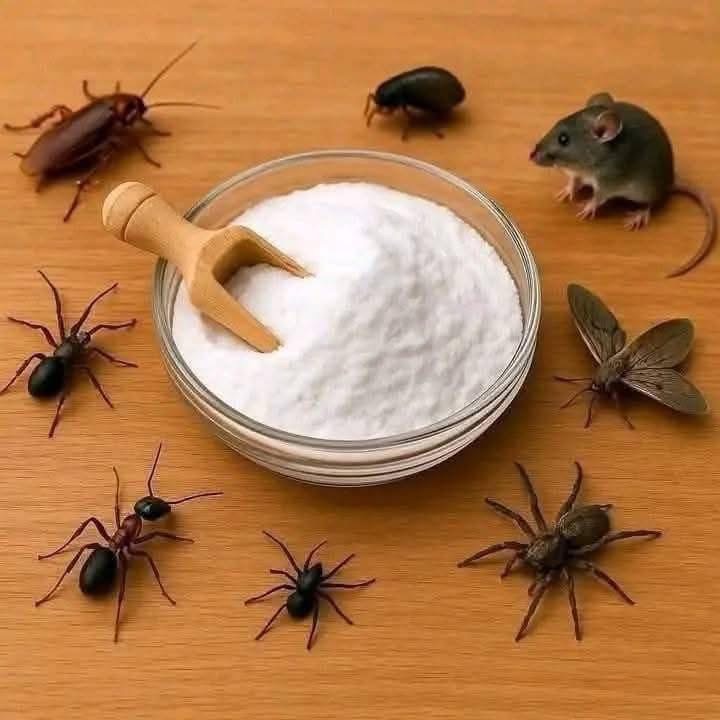
Baking Soda: The Natural Pest Control Powerhouse
Introduction
Household pests like ants, cockroaches, spiders, flies, beetles, and even mice are not only a nuisance but can also pose health risks and cause structural damage. Many people immediately turn to chemical pesticides and poisons, but these come with their own dangers—especially in homes with children or pets.
Enter baking soda (sodium bicarbonate), a humble kitchen ingredient with powerful pest-repelling and pest-killing properties. Affordable, non-toxic, and widely available, baking soda offers a natural, safe, and effective alternative to synthetic pesticides.
What is Baking Soda?
Sodium bicarbonate (NaHCO₃), commonly known as baking soda, is a white, crystalline powder with mildly alkaline properties. It’s commonly used in baking, cleaning, deodorizing, and now—pest control.
Baking soda works against pests in several ways:
- It disrupts their internal systems when ingested.
- It creates an inhospitable environment for nesting.
- It can kill pests when combined with other household ingredients.
How Baking Soda Affects Different Pests
1. Ants
Mechanism: When ants ingest baking soda, it reacts with the acid in their digestive system and creates gas. Ants cannot expel gas, so this leads to internal rupture and death.
How to Use:
- Mix equal parts baking soda and powdered sugar. The sugar attracts the ants, and the baking soda kills them.
- Place the mixture in small shallow containers or bottle caps near ant trails and entry points.
2. Cockroaches
Mechanism: Baking soda kills roaches similarly—it reacts internally and causes a fatal buildup of gas.
How to Use:
- Combine equal parts baking soda and sugar or onion powder.
- Leave the mixture in dark corners, under sinks, behind stoves, and in cabinets.
- Repeat daily until infestations diminish.
3. Mice
Mechanism: Like insects, mice cannot belch or vomit. When they ingest baking soda, the gas it produces expands inside their body, causing death.
How to Use:
- Mix flour, sugar, and baking soda in equal parts.
- Shape into small balls or place the dry mix in shallow dishes.
- Leave near suspected mouse activity (but use caution around pets).
4. Spiders
Mechanism: Baking soda doesn’t necessarily kill spiders on contact, but it repels them and discourages them from nesting.
How to Use:
- Sprinkle baking soda along windowsills, doorways, behind furniture, and in corners.
- Reapply weekly for prevention.
5. Flies
Mechanism: Baking soda helps remove fly breeding grounds and can be part of traps that eliminate them.
How to Use:
- Clean drains and garbage areas with a mix of baking soda and vinegar.
- Make a trap by combining baking soda, sugar, and a bit of dish soap in a bowl with water.
6. Beetles and Other Insects
Mechanism: Many beetles ingest or come in contact with baking soda, which affects their metabolism and causes dehydration or internal damage.
How to Use:
- Sprinkle baking soda in areas where beetles gather: under appliances, in pantries, or windowsills.
- Can also be mixed with a small amount of flour or sugar to attract and kill them.
Additional Pest Control Uses of Baking Soda
1. Drain Cleaning (against fruit flies and gnats)
- Pour ½ cup of baking soda down the drain, followed by ½ cup of vinegar.
- Wait 10 minutes and flush with hot water.
- This kills fly larvae and eliminates odors that attract pests.
2. Deodorizing Garbage & Litter Boxes
- Sprinkle baking soda in trash cans, recycling bins, and litter boxes to neutralize smells that attract flies, roaches, and rodents.
3. Cleaning Pet Areas
- Use baking soda to clean pet beds, feeding areas, and litter boxes to reduce odors and pest attraction.
Tips for Effective Use
- Keep mixtures dry for maximum effectiveness unless specified (e.g., drain cleaning).
- Place bait in low-traffic, pest-prone areas—especially near nests, under furniture, or dark corners.
- Avoid contamination with water or strong odors that might repel pests.
- Reapply mixtures every 2–3 days for ongoing infestations.
- Monitor pest activity and adjust bait placement as needed.
Safety Considerations
- Baking soda is non-toxic to humans and most pets in small amounts.
- However, large quantities can cause digestive upset if eaten—keep bait out of reach of children and pets.
- Always label homemade pest control baits and store them safely.
Limitations of Baking Soda
- It works best for small to moderate infestations.
- Severe infestations may require a combination of methods or professional extermination.
- It is not an immediate kill—results may take a few days to be visible.
Conclusion
Baking soda is a remarkably versatile substance—not just in the kitchen, but as a natural, affordable, and safe pest control method. It may not replace professional pest control in every situation, but for everyday prevention and mild infestations, it’s a powerful ally.
Whether you’re dealing with ants in the pantry, roaches under the sink, or mice in the walls, baking soda can be a crucial first line of defense. And best of all? It’s already in your cupboard.